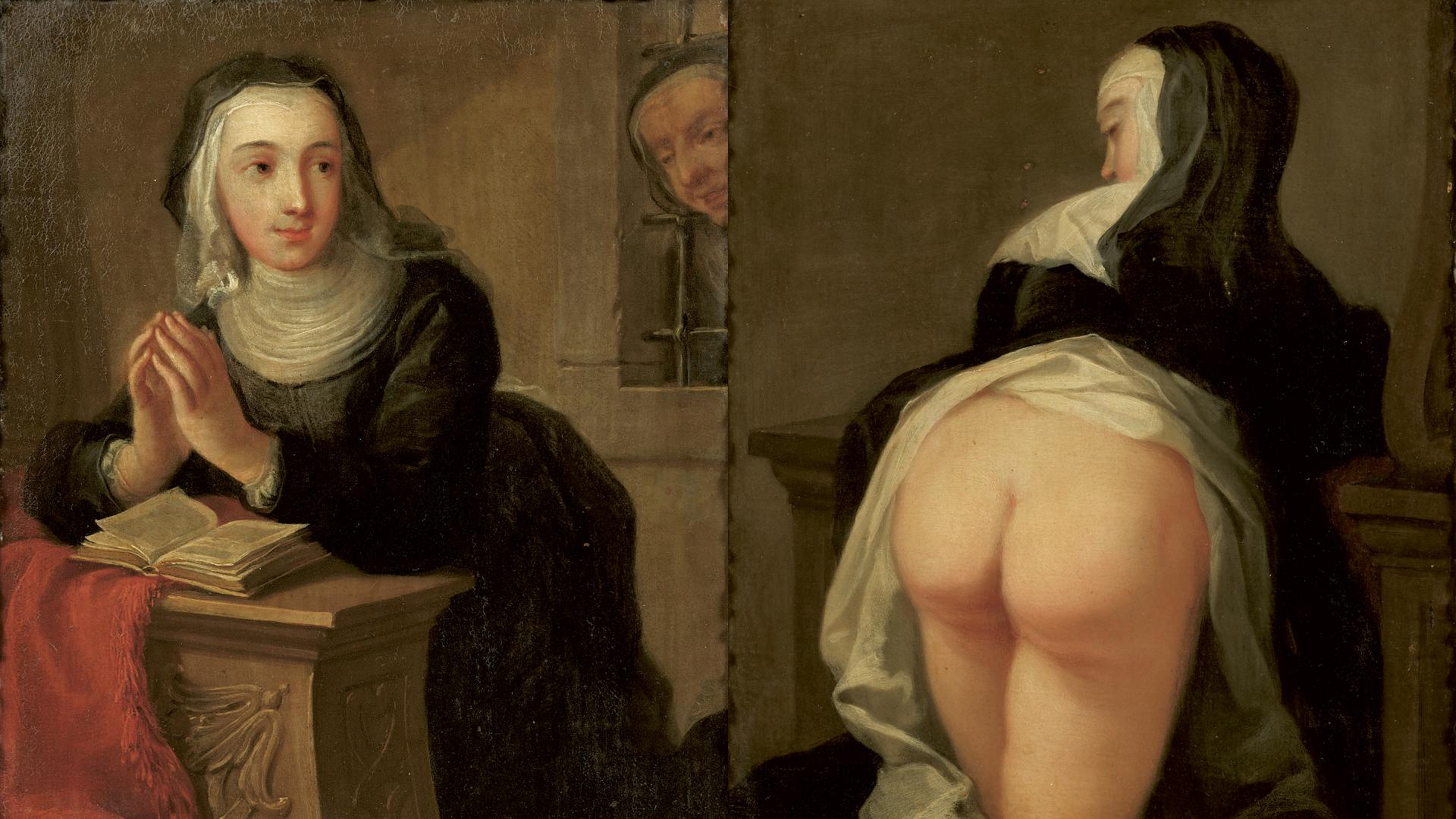Revealing the hidden side of a work is the promise of Reversos (Envers), the latest exhibition at the Prado Museum in Madrid, where the public can discover the surprising reverse side of the paintings, the unsuccessful attempts or the hidden messages of the artists. In short, behind the scenes. It was the most famous painting in the Prado that inspired the idea for the exhibition: Velázquez's Las Meninas. On this immense and enigmatic canvas the painter himself appears facing the viewer, behind his easel. A mirror effect which has fueled numerous theses in the world of painting.
It is a faithful reproduction of the back of the work which welcomes the public, an immense wooden frame measuring 3.6 m by 3.2 m placed on the ground, which increases the impression of the gigantism of the canvas. “This exhibition goes well beyond the simple fact of turning the paintings on the wall,” explains its curator, Miguel Ángel Blanco.
The latter inspected the Prado funds for seven years. “I saw all the backs of the paintings. Front and back,” he said. Loans from 29 international museums and collections were added. Among them, a self-portrait by Vincent Van Gogh, exhibited for the first time in the Spanish museum, whose easel occupies the foreground. A similar scene of the Painter in his studio by Rembrandt, also hung. Titian, Magritte, Goya and, more recently, Sophie Calle complete the collection.
Staging, mise en abyme, trompe l'oeil, hidden scribbles, messages scribbled by the artist, the works can be examined from every angle, sharpening a curiosity flirting with indiscretion. In rooms with entirely black walls, other works are, like jewelry, displayed in display cases around which the public can wander. The paintings become objects available to the eye, without any more secrets. It's about changing the viewer's point of view and taking them behind the scenes of creation and the museum, where they would never have access, to open "a dimensional door to the secrets of art », explains Miguel Ángel Blanco.
Several paintings reveal crossed out sketches and unfinished projects, while the front is perfectly done. Also included is the original stretcher of one of the most famous paintings in the world, Guernica, found two years ago in the reserves of the MOMA in New York. “They discovered these crossbars and this label that said 'Picasso, San Francisco' because he traveled through 30 cities. He was pinned and unhooked 45 times. It’s the most crucified frame in history,” says the commissioner, pointing to the holes that dot the wooden structure. As for this black trace, it is “the unknown brushstroke of Guernica, a brushstroke which escaped Picasso and which remained on this frame”, he enthuses.
A work by Michelangelo Pistoletto (Easel on Canvas, 1962-1975) features the audience, who are reflected in a full-length mirror on which an easel has been painted, transforming the spectator into an artist like Velázquez in Las Meninas. A painting by Martin van Meytens (1731) makes you smile: face A, the kneeling Good Sister shows a nun in front of a prayer table, while behind her back another sister seems to be speaking to her. Face B, the same nun stands in the same position and, seen from behind, has her alb raised on her back, her buttocks exposed and her stockings decorated with a red bow, all exhibited to the other Carmelite.
The mischievous photos of Eliott Erwitt, one of the Magnum agency photographers who died last month, immortalizing spectators at the Prado brighten up the journey: we see a group of men huddled together in front of a female nude next to a painting showing a dressed woman in front of whom stands a single spectator. Inaugurated in November, the exhibition will be held until March 3, 2024.

 B:SM will break its investment record this year with 62 million euros
B:SM will break its investment record this year with 62 million euros War in Ukraine: when kyiv attacks Russia with inflatable balloons loaded with explosives
War in Ukraine: when kyiv attacks Russia with inflatable balloons loaded with explosives United States: divided on the question of presidential immunity, the Supreme Court offers respite to Trump
United States: divided on the question of presidential immunity, the Supreme Court offers respite to Trump Maurizio Molinari: “the Scurati affair, a European injury”
Maurizio Molinari: “the Scurati affair, a European injury” First three cases of “native” cholera confirmed in Mayotte
First three cases of “native” cholera confirmed in Mayotte Meningitis: compulsory vaccination for babies will be extended in 2025
Meningitis: compulsory vaccination for babies will be extended in 2025 Spain is the country in the European Union with the most overqualified workers for their jobs
Spain is the country in the European Union with the most overqualified workers for their jobs Parvovirus alert, the “fifth disease” of children which has already caused the death of five babies in 2024
Parvovirus alert, the “fifth disease” of children which has already caused the death of five babies in 2024 Inflation rebounds in March in the United States, a few days before the Fed meeting
Inflation rebounds in March in the United States, a few days before the Fed meeting Video games: Blizzard cancels Blizzcon 2024, its annual high mass
Video games: Blizzard cancels Blizzcon 2024, its annual high mass Falling wings of the Moulin Rouge: who will pay for the repairs?
Falling wings of the Moulin Rouge: who will pay for the repairs? “You don’t sell a company like that”: Roland Lescure “annoyed” by the prospect of a sale of Biogaran
“You don’t sell a company like that”: Roland Lescure “annoyed” by the prospect of a sale of Biogaran Exhibition: in Deauville, Zao Wou-Ki, beauty in all things
Exhibition: in Deauville, Zao Wou-Ki, beauty in all things Dak’art, the most important biennial of African art, postponed due to lack of funding
Dak’art, the most important biennial of African art, postponed due to lack of funding In Deadpool and Wolverine, Ryan and Hugh Jackman explore the depths of the Marvel multiverse
In Deadpool and Wolverine, Ryan and Hugh Jackman explore the depths of the Marvel multiverse Tom Cruise returns to Paris for the filming of Mission Impossible 8
Tom Cruise returns to Paris for the filming of Mission Impossible 8 Skoda Kodiaq 2024: a 'beast' plug-in hybrid SUV
Skoda Kodiaq 2024: a 'beast' plug-in hybrid SUV Tesla launches a new Model Y with 600 km of autonomy at a "more accessible price"
Tesla launches a new Model Y with 600 km of autonomy at a "more accessible price" The 10 best-selling cars in March 2024 in Spain: sales fall due to Easter
The 10 best-selling cars in March 2024 in Spain: sales fall due to Easter A private jet company buys more than 100 flying cars
A private jet company buys more than 100 flying cars This is how housing prices have changed in Spain in the last decade
This is how housing prices have changed in Spain in the last decade The home mortgage firm drops 10% in January and interest soars to 3.46%
The home mortgage firm drops 10% in January and interest soars to 3.46% The jewel of the Rocío de Nagüeles urbanization: a dream villa in Marbella
The jewel of the Rocío de Nagüeles urbanization: a dream villa in Marbella Rental prices grow by 7.3% in February: where does it go up and where does it go down?
Rental prices grow by 7.3% in February: where does it go up and where does it go down? Even on a mission for NATO, the Charles-de-Gaulle remains under French control, Lecornu responds to Mélenchon
Even on a mission for NATO, the Charles-de-Gaulle remains under French control, Lecornu responds to Mélenchon “Deadly Europe”, “economic decline”, immigration… What to remember from Emmanuel Macron’s speech at the Sorbonne
“Deadly Europe”, “economic decline”, immigration… What to remember from Emmanuel Macron’s speech at the Sorbonne Sale of Biogaran: The Republicans write to Emmanuel Macron
Sale of Biogaran: The Republicans write to Emmanuel Macron Europeans: “All those who claim that we don’t need Europe are liars”, criticizes Bayrou
Europeans: “All those who claim that we don’t need Europe are liars”, criticizes Bayrou These French cities that will boycott the World Cup in Qatar
These French cities that will boycott the World Cup in Qatar Euroleague: at the end of the suspense, Monaco equalizes against Fenerbahçe
Euroleague: at the end of the suspense, Monaco equalizes against Fenerbahçe Women's Six Nations: Where to see and five things to know about France-England
Women's Six Nations: Where to see and five things to know about France-England Liverpool: it is confirmed, Slot will succeed Klopp on the Reds bench
Liverpool: it is confirmed, Slot will succeed Klopp on the Reds bench Ligue 1: Montpellier and Nantes back to back, two reds in stoppage time
Ligue 1: Montpellier and Nantes back to back, two reds in stoppage time


















